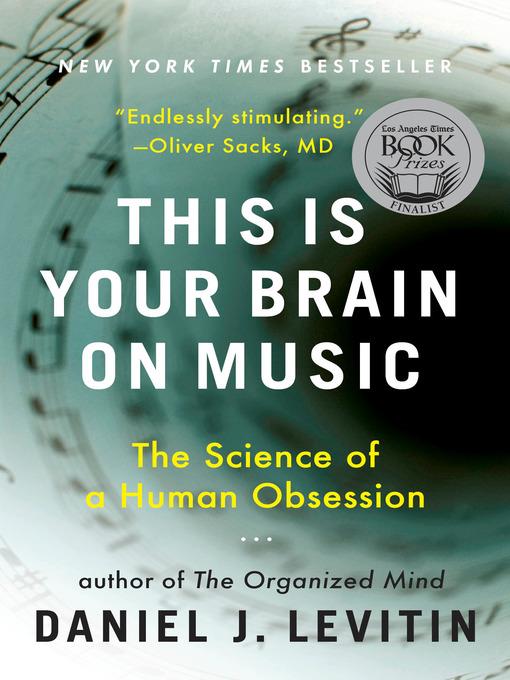
This Is Your Brain on Music
The Science of a Human Obsession
کتاب های مرتبط
- اطلاعات
- نقد و بررسی
- دیدگاه کاربران
نقد و بررسی

Starred review from May 15, 2006
Think of a song that resonates deep down in your being. Now imagine sitting down with someone who was there when the song was recorded and can tell you how that series of sounds was committed to tape, and who can also explain why that particular combination of rhythms, timbres and pitches has lodged in your memory, making your pulse race and your heart swell every time you hear it. Remarkably, Levitin does all this and more, interrogating the basic nature of hearing and of music making (this is likely the only book whose jacket sports blurbs from both Oliver Sacks and Stevie Wonder), without losing an affectionate appreciation for the songs he's reducing to neural impulses. Levitin is the ideal guide to this material: he enjoyed a successful career as a rock musician and studio producer before turning to cognitive neuroscience, earning a Ph.D. and becoming a top researcher into how our brains interpret music. Though the book starts off a little dryly (the first chapter is a crash course in music theory), Levitin's snappy prose and relaxed style quickly win one over and will leave readers thinking about the contents of their iPods in an entirely new way.

Starred review from July 1, 2006
In this exploration of the brain-music relationship, musician and neuroscientist Levitin, who heads the Levitin Laboratory for Musical Perception, Cognition, and Expertise at McGill University, begins by defining and explaining musical terms. Lay readers can take these chapters as reference material; musicians and scientists will grasp the apparatus of organized sound, hearing, and brain function, structured in detail with examples ranging from Johann Sebastian Bach to the Beatles. Following that material is an explanation of how music arouses and plays with expectations, creates tension and resolution, and provides insights into brain structure and function. Levitin concludes with three delightful chapters: -What Makes a Musician? - (10,000 hours of practice), -My Favorite Things - (why we like what we like), and -The Music Instinct, - in which he argues -against experimental psychologist Steven Pinker -that music plays a role in evolution (singers and dancers are perceived as being more attractive as mates). In Levitin -s study, current brain research becomes comprehensible through music -a wonderful accomplishment. Along with Anthony Storr -s "Music and the Mind" and Kathleen Marie Higgins -s "The Music of Our Lives", this book extends the appreciation of music as neural training. Essential for most libraries." -E. James Lieberman, George Washington Univ. Sch. of Medicine, Washington, DC"
Copyright 2006 Library Journal, LLC Used with permission.

November 1, 2006
Adult/High School-Levitin's fascination with the mystery of music and the study of why it affects us so deeply is at the heart of this book. In a real sense, the author is a rock 'n' roll doctor, and in that guise dissects our relationship with music. He points out that bone flutes are among the oldest of human artifacts to have been found and takes readers on a tour of our bio-history. In this textbook for those who don't like textbooks, he discusses neurobiology, neuropsychology, cognitive psychology, empirical philosophy, Gestalt psychology, memory theory, categorization theory, neurochemistry, and exemplar theory in relation to music theory and history in a manner that will draw in teens. A wonderful introduction to the science of one of the arts that make us human."Will Marston, Berkeley Public Library, CA"
Copyright 2006 School Library Journal, LLC Used with permission.

July 1, 2006
How the brain processes all aspects of music is the subject of this book rooted in cognitive psychology, neuroscience, and the evolution of the brain. Levitin starts with how the ear perceives sound vibrations--signals are processed in the brain's audio cortex--and proceeds to the perception of frequencies, scales, and timbre, coupled with rhythm and tempo, exploring them within cultural context. Music triggers emotional responses, which, in interaction with the perceptions, are transmitted throughout the brain, eliciting responses colored by the personal likes and dislikes that have developed as the brain has grown. Levitin, first a musician and recording producer, is now a neuroscientist teaching the psychology of electronic communications at McGill University, and he draws many examples of how the brain receives and processes various inputs, including visual and aural, from art and classical and popular music. His book introduces the inner workings of the brain insofar as scientists understand it and affords a good first look at the subject for armchair psychologists and neuroscientists.(Reprinted with permission of Booklist, copyright 2006, American Library Association.)

























دیدگاه کاربران